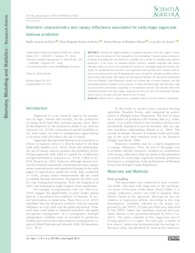Biometric characteristics and canopy reflectance association for early-stage sugarcane.
Biometric characteristics and canopy reflectance association for early-stage sugarcane.
Authorship: ROCHA, M. G. da; BARROS, F. M. M. de; OLIVEIRA, S. R. de M.; AMARAL, L. R. do
Summary: ABSTRACT: Knowing the spatial variability of sugarcane biomass in the early stages of development may help growers in their management decision-making. Proximal canopy sensing is a promising technology that can identify this variability but is limited to quantifying plant-specific parameters. In this study, we evaluated whether biometric variables integrated with canopy reflectance data can assist in the generation of models for early-stage sugarcane biomass prediction. To substantiate this assertion, four sugarcane-producing fields were measured with an active crop canopy sensor and 30 sampling plots were selected for manually quantifying chlorophyll content, plant height, stalk number and aboveground biomass. We determined that Random Forest and Multiple Linear Regression models are similarly able to predict biomass, and that associating biometric variables such as number of stalks and plant height with reflectance data can assist model performance, depending on the attributes selected. This indicates that, when estimating biomass in the early stages, sugarcane growers can carry out site-specific management in order to increase yield and reduce the use of inputs.
Publication year: 2019
Types of publication: Journal article
Observation
Some of Embrapa's publications are published as ePub files. To read them, use or download one of the following free software options to your computer or mobile device. Android: Google Play Books; IOS: iBooks; Windows and Linux: Calibre.
Access other publications
Access the Agricultural Research Database (BDPA) to consult Embrapa's full library collection and records.
Visit Embrapa Bookstore to purchase books and other publications sold by Embrapa.

